#medieval brooch
Photo
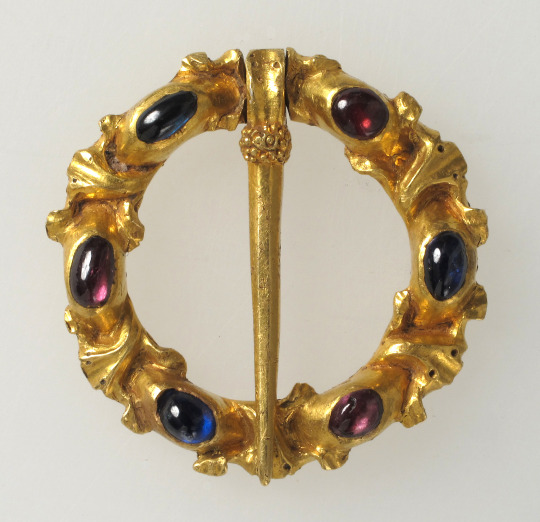
Ring Brooch (British or French, 1250–1300).
Gold, sapphire, garnet.
Image and text information courtesy The Met.
128 notes
·
View notes
Text
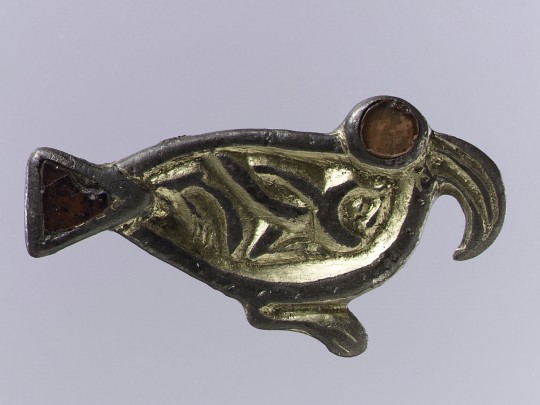

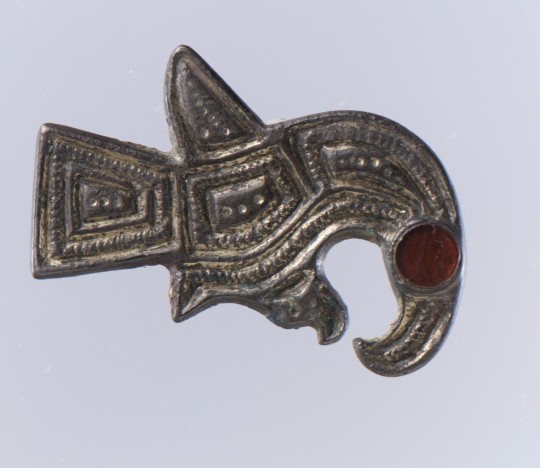
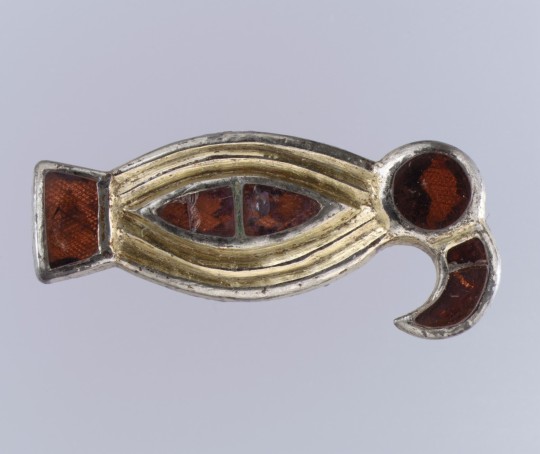


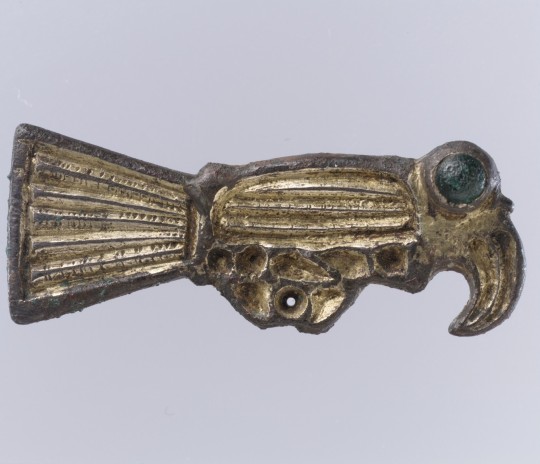

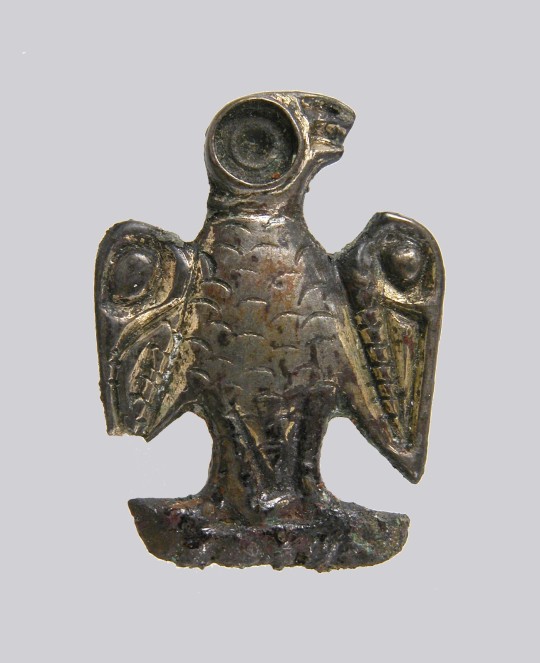

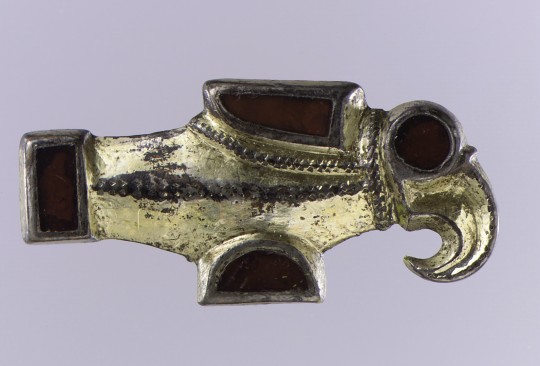


Apropos of nothing, here is a baker's dozen images of bird-shaped brooches ca. 6th century, from Frankish, Vendel, and Anglo-Saxon artisans. They all come from the Metropolitan Museum of Art collection on JSTOR, which includes nearly half a million open access images for everyone!
#medieval art#6th century#brooch#jewelry#birds!#research#jstor#do people still say baker's dozen?#open access
5K notes
·
View notes
Text
I precise it’s a piece of jewellery you can wear either daily or only for special occasions like weddings, you choose!And there isn’t a ‘none’ option because this isn’t a post for cowards.
#I’d wear Arwen’s necklace anyday and almost bought a replica at the medieval faire this summer but didn’t have the money#but also the leaf of lorien brooch is just gorgeous and I love wearing brooches#and I already have hair beads but my hair’s still too short to properly braid them in so it’ll wait#and for special occasions I’d totally give it a go to the ring of barahir#tolkien#the lord of the rings#tolkien polls#lotr poll#nenya#narya#vilya#the one ring#ring of barahir#leaf of lórien#jewellery#lotr jewellery
640 notes
·
View notes
Text
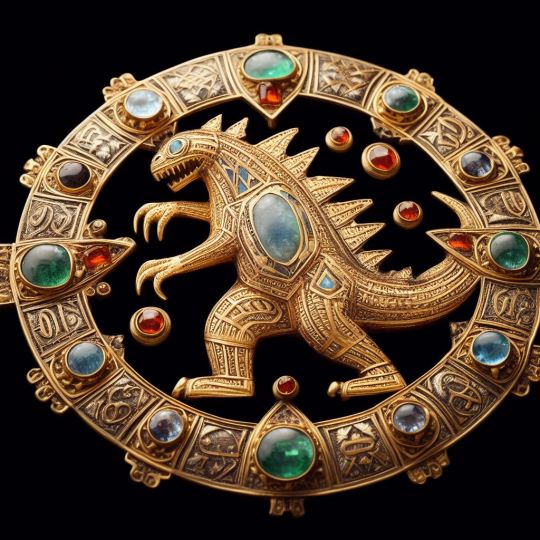
Restored Anglo-Saxon Godzilla brooch
306 notes
·
View notes
Text



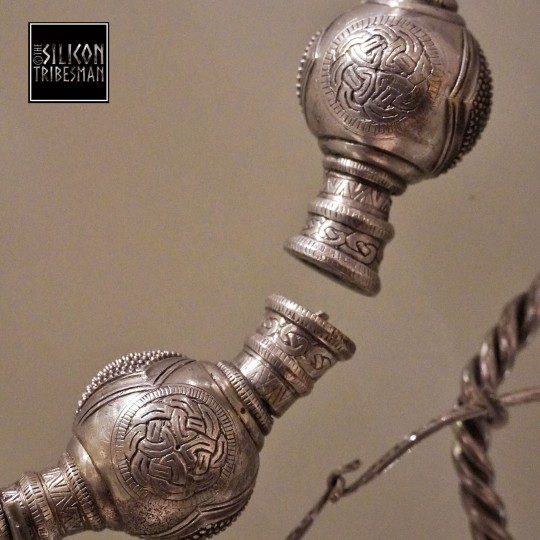

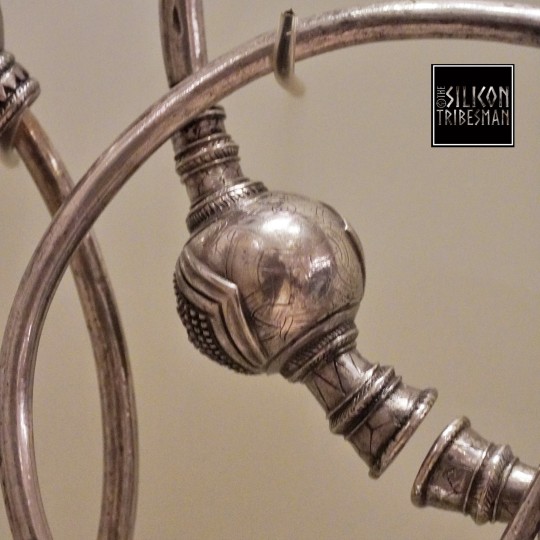

Detailing from Early Medieval Silver Decorated Pennanular Brooches, The National Museum of Scotland, Edinburgh
#silver#silver brooch#brooch#Pennanular Brooches#archaeology#relic#early medieval#wealth#status#Scotland#Edinburgh#artefact#jewellery#costume#ancient craft#ancient cultures#ancient living
113 notes
·
View notes
Text
45 notes
·
View notes
Text

The sequel to my nun habit reference. Something for the boys this time with 2x the ramblings
#the visby lens and penannular brooch are REALLY pushing German boundaries but given he's a crow-collector yknow it could happen#medieval#middle ages#14th century#medieval costuming#oc:loys#eggface art
18 notes
·
View notes
Text
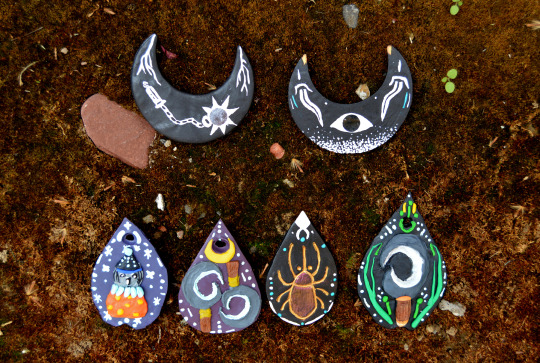
Updated my brooches! Moons and a beetle!
( Strixes' Sabre )
#brooch#moon#beetle#witchcraft#occult#sickle#wool hat#pin back#medieval weapon#swords#esoteric#goth#owl#moon phase
5 notes
·
View notes
Text
I’ve been down a rabbit hole wondering about medieval jewelry (and if I can reproduce it despite having no metalworking skills, to which the answer is mostly no) lately & I figured I would share the fruits of my museum collection searches for other medievalists/hobbyists/reenactors/nerds.
Jewelry of the 13th Century Anglo/Francosphere

TL;DR
Metals: 🟨 gold(tone)
Stones: mostly 🔵 cabochon, rarely 💠 simple cut, some carved 🗿 intaglio or cameo
Stone Colors: warm blues, emerald green, purples, burgundies, reds
Materials: enamel, 💎 gemstones (garnet, Ceylon sapphire, ruby/spinel, emerald) or glass paste imitations, ⚪ semi-precious stones (pearl, lapis, jasper, carnelian, coral, turquoise, porphyry)
Settings: bezel (oval and rectangular); ⚜️ intricate metalwork; more visible and textured metal than modern jewelry; more mixtures of stones and colors than modern tastes
Motifs: ◯ round, ✤ quatrefoil, ✙ cross, ✸ star (even numbers of points), ♣ trefoil, ❦ floral, 🐉 animals, 𝕬 inscription
Formats: brooches, ornamented clothing, rings, pendants, circlets, cuffs (rare)
A detailed look:
Some forms of jewelry that were very popular in the Roman Empire and are again today were just not the thing in the middle European Middle Ages. (Earrings, for example, seem to have barely existed. This is partially at least because ears were covered--by coifs and caps, hair, and (for women) braids or the chin strap and fillet/wimple/gorget.) In fact, a lot of the places we would put jewelry against our skin today were covered.
This left some other options:
Jewelry on Clothing
Medallions
Okay, these aren’t jewelry, strictly speaking, but they’re metalwork ornaments associated with a person.
Enamel Mitre Medallions


OA 3437 and OA 3438
Before 1291, Ile de France
Louvre, Paris
photos (c) Musée du Louvre / Stéphane Maréchalle 2015
Cloisonné and plique enamel over gold and copper, with decorative motifs of trefoils, quatrefoil, and stars in a palette of dark blue and green with accents that may once have been ruby red.
Appliqué Medallion
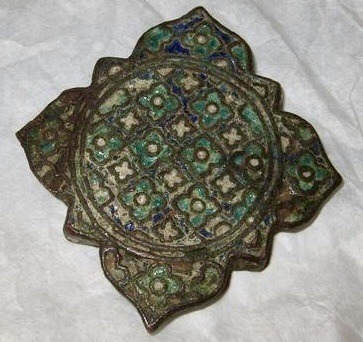
# MRR 256
13th c., Limoge
Louvre, Paris
photo (c) Musée du Louvre 2014
Gilded copper (though most gold is worn off) with quatrefoil champlevé enamel in emerald green, lapis blue, and white or off-white.
Brooches
Perhaps the most prevalent medieval jewelry item in the Anglo & French regions. These were worn at the shoulder for men and breast for women, often anchoring a cloak, or to close the collar. As the ornate fermail and double-ring brooch suggest, these ran the gamut from practical to incredibly decorative and ornate.
Garnet & Silver Gilt Animal Ring Brooch; Green and Blue Glass and Gilt Ring Brooch


Left, # 2003,0703.1
13th century; found in Suffolk, England
British Museum, London
photo (c) The Trustees of the British Museum
Right, # M.28-1929
13th c., England
V&A, London
photo © Victoria and Albert Museum, London
Cabochon garnets or carbuncles in the gilded silver brooch (L), perhaps once paired with smaller stones in the eyes of metalwork animals that bite the pin bracket. The right brooch, also silver gilt, sports two glass paste emerald and sapphire "gems" in cabochon. It was probably a lover's token; it reads (in Lombardic-lettered French) IOSV ICI ATI VCI or "jo su[i] ici a t[o]i v[o]ici" which I might translate as "I am here with/belonging to you, look!"
Ruby & Sapphire Ring Brooch; Sapphire, Garnet, and Pearl Fermail
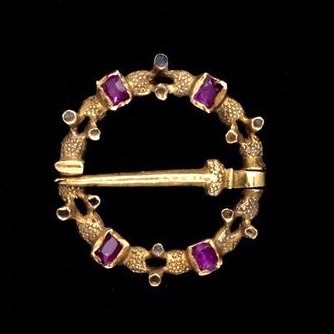
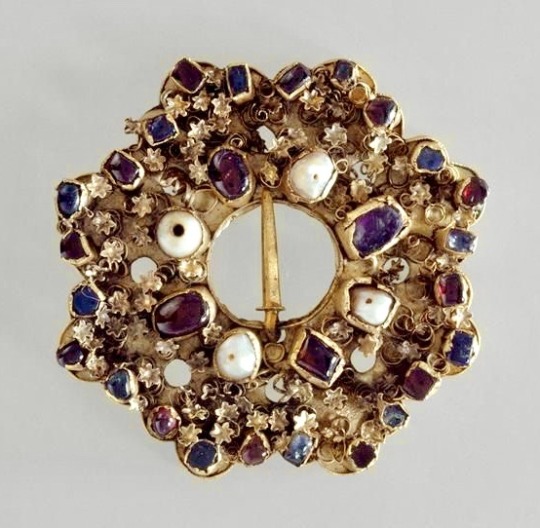
Left, # 6808-1860
1275-1300, England
V&A, London
photo © Victoria and Albert Museum, London
Right, # OA6287
1250-1300, France
Louvre, Paris
photo (c) Musée du Louvre
Blogs often claim that stones were only polished en cabochon until the 16th century, and that medieval jewelers couldn't cut gemstones. But this 13th-century gold ring brooch (left) pairs table-cut purple rubies with collet-set cabochon sapphires, and may evidence early medieval gem-cutting or reuse of Roman cut stones. The silver gilt fermail, right, includes pearl beads, garnets and sapphires both cut and cabbed, and one glass paste cabochon. Both are intricately textured, with punchwork (L) and floral metalwork, probably cast and then attached (R).
Double Ring Brooch with Sapphire and Glass "Emeralds"
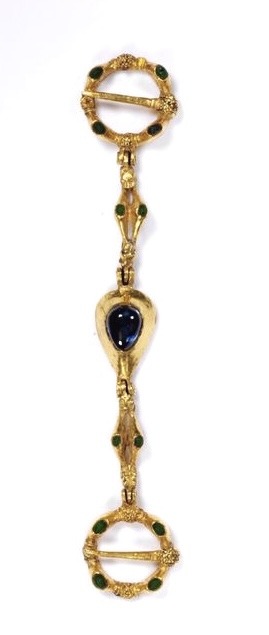
# M.26-1993
13th c., England
V&A, London
photo © Victoria and Albert Museum, London
This gold double brooch is so small they think it was for a woman or child. Central sapphire cab is flanked by glass paste "emeralds" in bezel settings and metalwork featuring two animal heads.
Jewelry on the Body
Rings
Many are probably familiar with the signet ring, used for pressing into sealing wax, which could be intaglio-carved gemstone or metals. There were also a number of decorative and/or talismanic gemstone rings.


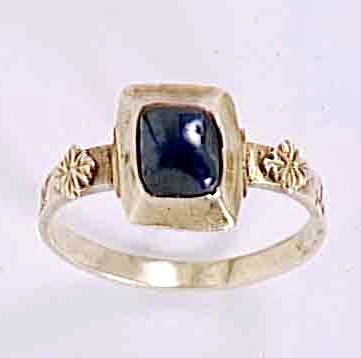
LtR:
#M.7-1929 | #M.180-1975 | #OA 11265
1250-1300, England | 1250-1300, Engl/France | 13th c., Engl/France
V&A, London | V&A, London | Louvre, France
photos L&C © Victoria and Albert Museum, London | R (c) Musée du Louvre
Sapphire in gold is the name of the game when it comes to rings in the thirteenth century; even the purple stones on the left are purple sapphires. (Sapphires were said to aid chastity, purity, and the effectiveness of prayer.) For larger stones, the bezel often has claws added (L); the central ring is an example of a full claw setting that modern viewers might find surprisingly tall. Naturalistic flourishes are added (C & R); these might be pre-cast then attached to the base (R).
Pendants
We equate pendants with necklaces, but their medieval applications also included wear as badges, from headpieces, and on horse decorations.


Left, bloodstone jasper cameo in silver setting
# MRR 218
1100-1300, France?
Louvre, Paris
photo (c) Musée du Louvre / Jean Blot 1984
Right, champlevé enamel, gilt copper, and paste "emerald" (harness) pendant
# 1976.169
13th c., France
Cleveland Museum of Art, Cleveland
photo CC0 Open Access
Statue Jewelry
From here, we get into the really ridiculous stuff; the previous categories could be relatively everyday (as much as ornamentation reserved exclusively for the wealthy can be an everyday thing) but the following examples are astonishing displays not necessarily for wear.
"La Couronne" de Vierge et l'Enfant d'ivoire de la Sainte-Chapelle

# OA 57 B
1250-1300, France
Louvre, Paris
photo (c) Musée de Louvre
This was not even a crown for a person, but rather for a painted ivory statue of the Virgin Mary, holding her infant son. (Though circlets, even set with stones, were sometimes worn as part of women's head dress.) It's incredibly ornate gold, set with pearls, garnets and rubies, sapphires, and turquoise (?) en cabochon.
Anneau de Saint-Denis




# MS 85 BIS
1200-1215, France
Louvre, Paris
photos (c) Musée du Louvre / Daniel Arnaudet 1990
This astonishing piece, which is ring-sized but now displayed as a cuff on an ivory hand, is made of gold and displays every possible gemstone appearance characteristic of the period. The front piece has a central sapphire and is surrounded by quartz with red backing (mimicking ruby/garnet), amethysts, pearls, and sapphires, some set on yellow backing (mimicking turquoise?). Most are en cabochon on this face, but two are faceted and two intaglio. Were this not enough, the three other 'faces' of the ring are set with gems as well, two cameos (probably sapphire and garnet?) and one amethyst intaglio set in ornate gold filigree.
#medieval#jewelry making#lapidary#history of fashion#historical jewelry#1200s#reenactment#England#France#enamel jewelry#ring brooch#fermail#intaglio#cameo#gemstones#infodumping#now time to go to the bead store#material history#you would think this is for my research or academically relevant but it's not I just couldn't stop looking at shiny things help#photos not mine#photos for educational purposes and not for commercial reproduction#louvre#v&a museum#british museum#cleveland museum of art
35 notes
·
View notes
Photo
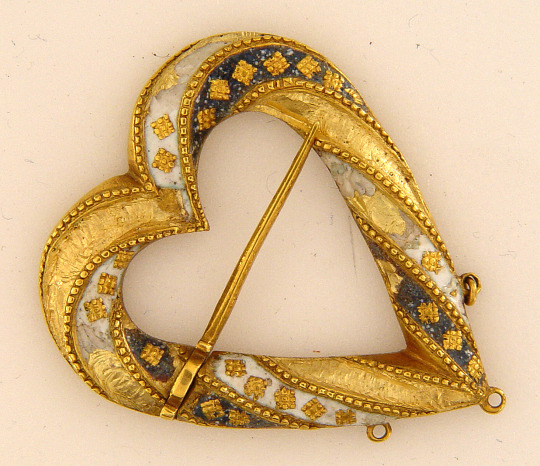

Late Medieval (1400-1464) heart-shaped gold brooch with twisted bands of blue and white enamelling.
Inscription on the back 'Je suy vostre sans de partier' (I am yours forever).
© The Trustees of the British Museum.
Creative Commons Attribution-NonCommercial-ShareAlike 4.0 International (CC BY-NC-SA 4.0) license.
4K notes
·
View notes
Note
I’ve legit never heard of the earrings = harlot thing before, but suddenly the scene in Grease where Frenchie wants to pierce Sandy’s ears makes a LOT more sense to me
Yep! Part of the whole Quaint '50s Retro setting was the idea that piercing one's ears was something bad girls did, on par with drinking and smoking. Plus the concept of doing it at a sleepover, when pierced ears had become normal again by 1978 and one could have it done at a doctor's office or a mall kiosk (though home piercing did still happen- hell, it's around to this day).
TANGENT: The "virgin pin" referenced in the scene, interestingly, was another name for the circle pins popular in the 1950s-early 1970s. I looked it up, curious as to whether the filmmakers had based that line on an urban legend. The idea of girls in the 1950s advertising their virginity or lack thereof seemed highly unlikely to me. But it was in fact an unofficial Thing- though there's a dispute as to the meaning.
One woman who was a teen in the late 50s-early 60s mentioned that she and her peers wore their pins on the left side of their chests, to signify that they were virgins. Girls who had "gone all the way" supposedly wore it on the right. But another blogger of the same age claimed that the wearers weren't even supposed to know the term. Rather, boys used it amongst themselves to indicate that the sort of girls who wore circle pins wouldn't put out before marriage.
What's interesting to me is that the term seems to have been widespread at least in the States, despite having different meanings in different places.
#ask#anon#grease#vintage fashion#history#fashion history#ear piercing#circle pins#1950s#of course that style of pin has been popular for centuries. you can probably find medieval circular brooches and older#I have one with hardware indicating that it's probably c. 1900-1910#they just had a popularity boom- and apparently a secret double-meaning -around the mid-20th century
81 notes
·
View notes
Text
Due diligence ahead of construction work in Switzerland has reaped its rewards. Finds included a stunning medieval gold brooch and a plethora of artifacts revealing secrets about life during the Dark Ages.
25 notes
·
View notes
Text

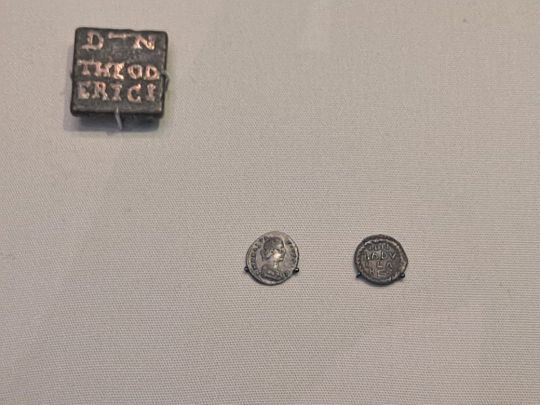

Ostrogothic Italy
490s-550s
Possibly made in Rome
British Museum
London, July 2022
#Ostrogothic kingdom#5th century#6th century#medieval#coin#brooch#Theodoric the great#Baduila#king#British Museum#my photo
53 notes
·
View notes
Text
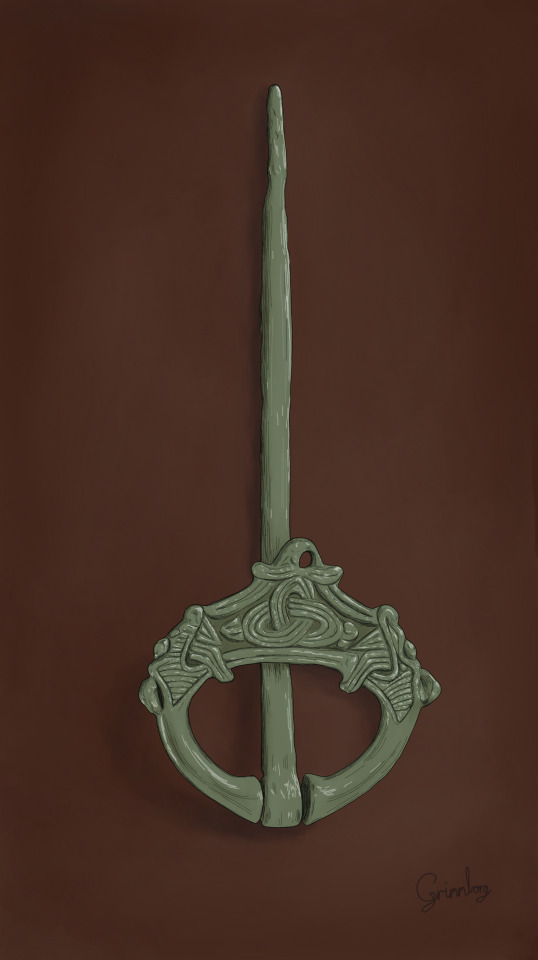
Dragon Headed Annular Brooch
I found this brooch so interesting because annular brooches tend to have either little to none or A LOT of decoration, but this one is just in between. Not nothing but not extravagant. Just medium.
There's another very similar one coming up soon that's been compared with this one due to size and decor amount.
Based on C21730 in Kulturhistorisk Museum

different rotation for good measure<3
#annular brooch#viking age#norse#archaeology#illustration#iron age#dragon#beast#triquetra#medieval#viking#brooch#bronze#sketchbook#ancient civilizations#history#details
29 notes
·
View notes
Text
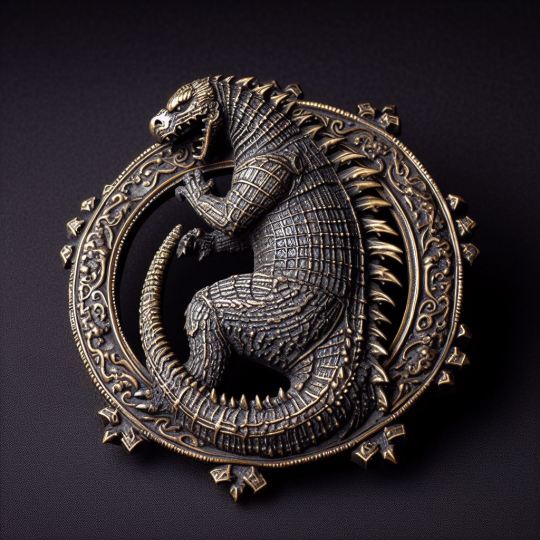
Restored medieval brooch featuring Godzilla c. 1100, Museum of the Middle Ages, Naples.
134 notes
·
View notes